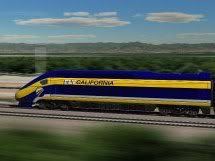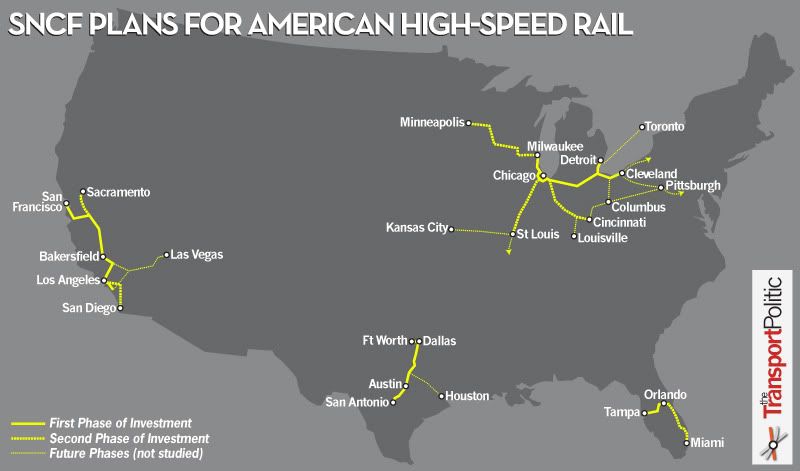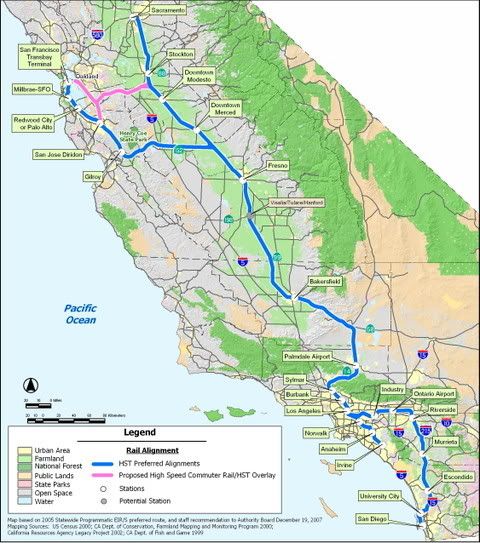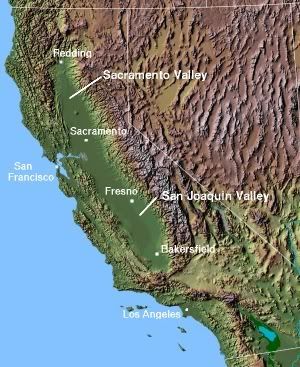(11 am. – promoted by ek hornbeck)
Burning the Midnight Oil for Living Energy Independence
 Last week, I looked at the California Legislative Analyst Office promoting a policy of raiding the California High Speed Rail funds to build commuter rail systems in LA and San Francisco by issuing what at first blush seemed to be simply a grossly incompetent analysis of the risks of building the HSR project.
Last week, I looked at the California Legislative Analyst Office promoting a policy of raiding the California High Speed Rail funds to build commuter rail systems in LA and San Francisco by issuing what at first blush seemed to be simply a grossly incompetent analysis of the risks of building the HSR project.
This week, I step back and take a broader view of why it would be idiotic to accept the LAO’s advice, as well as why it matters to people across the country, and not just the people of California who risk ongoing oil addiction of their intercity transport between Northern and Southern California.
The small matter of the Other 49 States
Remember what the other 49 States of these United States get from the California project.
If California builds an Express HSR system, we get information. We get ridership information. Apart from ignorance or a paycheck based on believing otherwise, connecting the Bay Area to the LA Basin by an intercity rail route that takes 3hrs or fewer is obviously going to get a substantial chunk of a quite large intercity transport market. Add in stations in the substantially under-served San Joaquin valley, and an Express HSR in this area is a slam dunk.
Indeed, while there have been critiques of the details of the specific ridership study used in the project EIR/EIS process, there’s no credible suggestion that it will fail to generate a substantial operating surplus. The uncertainty revolves around how big of an operating surplus can be expected.
The Bay Area to LA Basin transport market is so large that ridership projections do not require much precision to be confident that it shall be operating at a surplus. However, not every potential HSR corridor in the country is in that position. The more experience we have, the sooner we will be able to make a reasonable judgment where the margin lies between effective and ineffective investments in Express HSR.
And we do not have time to waste. Express HSR corridors, at least in high income nations that fortunately do not have China’s ability to run roughshod over local interests and rights to participation, take time to plan and build.
 California was one of four projects identified by the French High Speed Rail operator, SNCF, when it submitted its expression of interest in US High Speed Rail corridors: LA to SF, a hub and spoke system based on Chicago, DFW/San Antonio, and Florida. With the sound business case for Florida ignored in a politically-motivated attack, and with Texas stuck in neutral, that cuts our first rank opportunities for 220mph Express HSR corridors to California and the Chicago Hub.
California was one of four projects identified by the French High Speed Rail operator, SNCF, when it submitted its expression of interest in US High Speed Rail corridors: LA to SF, a hub and spoke system based on Chicago, DFW/San Antonio, and Florida. With the sound business case for Florida ignored in a politically-motivated attack, and with Texas stuck in neutral, that cuts our first rank opportunities for 220mph Express HSR corridors to California and the Chicago Hub.
We also get the regulatory precedents established. Rail regulation has been a backwater for a long time now, and as a result the Federal Rail Authority acts like the regulatory authority overseeing a backwater. Express HSR requires the FRA to work through decades of progress in safety and efficiency that other nations have made but which has until now passed the US by. And the only thing that will get the new regulatory system for Express HSR worked out and in place so those developing later projects know where they stand is the process of putting out the regulations for the first project.
We need, in brief, to catch up to the rest of the world in energy efficiency and oil independent intercity transport, and we can’t start catching up until we actually get started on catching up. With the Chicago Hub only starting to study 220mph corridor possibilities, while the opportunities in Florida and Texas are mired in partisan political gamesmanship ~ California is our first, best hope for gaining experience with running this technology in this country.
Whether that is the knowledge to pursue an Express HSR corridor or the knowledge to understand that some other approach is more appropriate for a particular intercity transport task, the sooner we know, the better.
Getting Oriented in California
The most common talking point among the new crop of anti-rail talking points against California HSR is the “train to nowhere”. That was because the original segment to be funded ran through Fresno and Hanford stations, with the northern end of the segment near Madera and the southern end near Corcoran, and experience by the propagandists paid to attack HSR projects was that the “train to nowhere” talking point was effective.
 “Why, if we build this corridor and nothing else, its a train from Madera to Corcoran”. Now, its obvious that the talking point is spread by a combination of conmen and those they have conned, from the facts they studiously ignored:
“Why, if we build this corridor and nothing else, its a train from Madera to Corcoran”. Now, its obvious that the talking point is spread by a combination of conmen and those they have conned, from the facts they studiously ignored:
- Fresno itself is not “nowhere”
- This is part of the Bay Area to LA corridor, the 2nd and 12th largest urban areas in the US, which is clearly not a “train to nowhere”, and
- if the HSR project was never finished, the fallback was to use the rail by the existing San Joaquin service, the 5th busiest Amtrak corridor in the nation ~ connecting to the Bay in Oakland and to Sacramento in the north, and to Bakersfield in the south, with an express bus connection to LA.
Of course, thanks to tea party Governors pledging to keep their state transport systems mired in the past, more HSR funds became available, and California was able to extend the corridor to run through Fresno to the entry into Bakersfield. Yet the bullshit factory is never one to drop a successful lie, so the train to nowhere lie continues to be repeated. If you have a chance to respond to it, “If you think LA to SF is a train to nowhere, you need your head examined”, or something along those lines, would be an appropriate response.
Why Build In the Valley First? Part 1: Private Investment
 More critically, though, this is a train to the future, and the future for oil-independent transport in California that connects Northern and Southern California is an Express HSR corridor. Its a mature, tested technology. When operated on sustainable power ~ as the CA-HSR Authority has committed to do ~ it has far less climate chaos impact than any alternative means of providing the same transport capacity. Its also cheaper than the available alternative means of providing the same transport capacity ~ California, given its ongoing budget crisis because of its broken budgeting process, simply cannot afford the luxury of sticking to the familiar but far more expensive alternatives of roadwork and airport expansion.
More critically, though, this is a train to the future, and the future for oil-independent transport in California that connects Northern and Southern California is an Express HSR corridor. Its a mature, tested technology. When operated on sustainable power ~ as the CA-HSR Authority has committed to do ~ it has far less climate chaos impact than any alternative means of providing the same transport capacity. Its also cheaper than the available alternative means of providing the same transport capacity ~ California, given its ongoing budget crisis because of its broken budgeting process, simply cannot afford the luxury of sticking to the familiar but far more expensive alternatives of roadwork and airport expansion.
Stage 1 is the San Francisco through to LA section ~ in the “double Y” map to the right, the SF leg of the top Y, and the Anaheim leg of the bottom (upside down) Y. The logical segments of this Stage are:
- From downtown SF to the exit from the Peninsula
- the connection from the Bay Area to the San Joaquin Valley
- the route through the San Joaquin Valley
- the connection to the LA Basin
- the route through LA, including LA Union Station, to the Anaheim Terminus
While its often referred to for convenience by the expected maximum speed of 220mph, it will not be going maximum speed through this whole route. It will, however, be running close to maximum speed through much of the San Joaquin valley.
And that is critical, for an obvious dollars-and-cents reason. Since Express HSR systems around the world generate operating surpluses, its possible to attract private investment to complete an operable segment of the California HSR system. Obviously, substantially better terms would be expected in negotiating this investment if the investment brings the system to the point of being able to begin operations. Also, it is useful for the train manufacturer to be part of the private consortium.
Now, one of the hurdles to be crossed in getting an operable segment up and running is certifying the trains to be used for operation. Since this will be a first-in-the-country train to be certified for operating above 200mph, a test track is required to certify the trains. Of course, private investment must include a far higher risk premium until trains have been certified, and no train manufacturer is going to join a private consortium to bid without a reasonable expectation that its trains will be used by the consortium if they win the bid.
 And if the fellow that the LAO assigned to write up their hatchet job of a risk analysis had ever clicked “terrain” on when engaged in Google Maps Tourism{TM} of the state, it would be obvious which segment of Stage 1 to build first, to be assured of having a 220mph test track.
And if the fellow that the LAO assigned to write up their hatchet job of a risk analysis had ever clicked “terrain” on when engaged in Google Maps Tourism{TM} of the state, it would be obvious which segment of Stage 1 to build first, to be assured of having a 220mph test track.
Now, the mid-20th century intercity transport infrastructure ~ roads and roadwork and airport and air traffic control ~ does not yield an operating surplus, so imaginations that are mired in the past just overlook this.
But for this 21st intercity transport infrastructure investment ~ and to be fair, it was already mature technology by the late 20th century ~ does generate operating surpluses. So the question of what segments have to be completed before negotiating with various rival private consortia has to be considered. And its obvious that the San Joaquin valley segment is part of that.
Why Build In the Valley First? Part 2: Minimum Operable Segments
The United States does not have an infrastructure bank that can assess and fund an application to fund a $20b or $40b or $60b project. So any state which has decided, as California did in 2008, to build a $10b’s project must pursue the project as a series of segments to be funded and built one after the other until the project has been completed.
For a transport corridor, it is often useful to get some part of the project up and running, even before the entire project has been completed. This is the idea of the “Minimum Operable Segment”.
For a project such as an intercity HSR corridor where the service can generate an operating surplus, the Minimum Operable Segment in terms of also being able to attract private investment should be a segment that can generate an operating surplus in its own right.
Now, consider doing as the California Legislative Analyst suggested, and spending the HSR funds on the two opposite ends of the segment. What would be needed to get a Minimum Operable Segment, in the sense of an operating surplus service?
- Anaheim to LA-Union Station wouldn’t be
- Anaheim to the southern end of the Central Valley alignment wouldn’t be
- Anaheim through to Bakersfield and Fresno probably would be
And what about from the other end?
- San Francisco to either San Jose or Fremont (depending on alignment) wouldn’t be
- San Francisco to the northern end of the Stage One San Joaquin Valley alignment wouldn’t be
- San Francisco through Fresno to Bakersfield probably would be ~ indeed, San Francisco / Fresno was the proposed first operating segment for the SNCF expression of interest in the California HSR corridor.
So, basically, follow the LAO’s preferred approach, and it becomes necessary to build all but one segment in order to have a minimum operable segment. And in either direction, one of the two starting projects does not start being used for HSR until the whole of Stage 1 is finished.
But what about if the Central Valley alignment is built first?
- Connect through to San Jose going north (or Fremont if the Dumbarton rail bridge is usable on a preliminary basis), and engage in some investment to allow the High Speed trains to finish their trip on the Caltrain Corridor, and there is a Minimum Operable Segment
- Or connect south through to the Antelope Valley line, either across the Tejon pass to Sylmar or the Tehachapi pass to Palmdale, and engage in some investment to allow the High Speed trains to finish their trip to LA Union Station on alignment presently used by Metrolink, and that is a Minimum Operable Segment
So, build the Central Valley alignment, and the system is one segment away from a minimum operable segment ~ in either direction, and two segments away from a minimum operable segment from the Bay to the LA Basin.
Why Build In the Valley First? Part 3: That’s What Is Funded
California put in applications for several segments, and the Department of Transport awarded California funds to build the Central Valley segment. Then, when more money became available, California applied for funds to extend that segment, and those funds were awarded.
And at the same time that California applied, in each round where California applied, there were $10b’s of project applications that were not funded.
The odds are that if California says, “you know what, we change our mind, we want to spend it on a different part of the route than the one you funded” ~ and also bearing in mind the first two points above, that California would be demanding the right to spend the money in a way that makes no sense in terms of attracting private investment, and makes no sense in terms of getting an Express HSR system up and running as soon as possible …
… the US DoT would say, “No”.
California’s big argument in winning these funds is that they are funds toward what promises to be the first 220mph Express HSR project in the country, with the state well advanced in the Environment Impact Report/Statement process, and with a majority of the California electorate already having approved $b’s in state bonding authority.
Following the LAO advice implies the maximum risk of never being able to get 220mph trains certified, and of not actually being the first state in the country to finishing building a 220mph Express HSR corridor. Why would the US Department of Transport give preference to a couple of expensive intra-urban commuter rail lines with an HSR brand name attached?
No reason. Indeed, what is the incentive to people in other parts of the county to support California getting their Express HSR project funded, if California demonstrates that they are not really serious about actually building an Express HSR system?
So not only is the Valley corridor the alignment that should be built first, if California is serious about linking Northern and Southern California by Express HSR … its the only alignment that has actually been awarded the funding to allow us to actually be built in the immediate future.
The Joy of FUD
Now, whether the paid propagandists of Reason, Cato, and Heritage believe in what they are saying, or primarily believe in paychecks that cash, they only get leverage if they can con others into falling for their talking points.
And Fear, Uncertainty and Doubt attacks on the California HSR are by no means limited to the paid propagandists of Big Oil. There is a history in California, perhaps encouraged by its broken state budgeting process, of “raiding” funds approved for one purpose in support of other projects. Politicians who are going to be termed out in 2012 are going to have a hard time benefiting politically from a service that is going to start running in another eight to ten years.
And over and above the temptation to “raid” HSR funds (despite the fact that the funds are likely to vanish in the face of an effort to do so), a State Senator like Smitian from the Silicon Valley facing a majority of constituents who support HSR, and a minority of passionate and vocal opponents, has a strong temptation to adopt the position that HSR “in general” is a great idea, but that whatever specifics are presently being proposed is a bad idea.
The reason Fear, Uncertainty and Doubt attacks are used is because they work. Get people tied up in detailed questions of which alignment to use and whether the project will end up saving 50% of the cost of equivalent road transport capacity or only save 35%, and they lose sight of the big picture.
But step back, and the FUD attack on starting in the Valley is nonsense. If you start by asking, “where would you start to get the best possible chance of finishing the system”, that’s exactly where you’d start.
Midnight Oil ~ Truganini

1 comments
Author
… sometimes starts with facing up to fierce opposition.